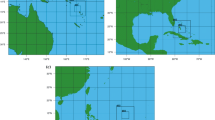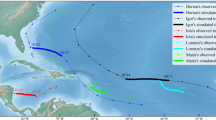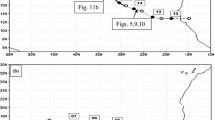Abstract
The rapid intensification of Hurricane Charley (2004) near landfall is studied using the fifth-generation Pennsylvania State University/National Center for Atmospheric Research (PSU/NCAR) Mesoscale Model (MM5) and its adjoint system for both vortex initialization and forecasts. A significant improvement in both track and intensity forecasts is achieved after an ill-defined storm vortex, derived from large-scale analysis, in the initial condition is replaced by the vortex generated by a four-dimensional data variational (4D-Var) hurricane initialization scheme. Results from numerical experiments suggest that both the inclusion of the upper-level trough and the use of high horizontal resolution (6 km) are important for numerical simulations to capture the observed rapid intensification as well as the size reduction during the rapid intensification of Hurricane Charley. The approach of the upper-level trough significantly enhanced the upper-level divergence and vertical motion within simulated hurricanes. Small-scale features that are not resolvable at 18 km resolution are important to the rapid intensification and shrinking of Hurricane Charley (2004). Numerical results from this study further confirm that the theoretical relationship between the intensification and shrinking of tropical cyclones based on the angular momentum conservation and the cyclostrophic approximation can be applied to the azimuthal mean flows.
Similar content being viewed by others
References
Bosart L E, Velden C S, Bracken W E, Molinari J, Black P G (2000). Environ-mental influences on the rapid intensification of Hurricane Opal (1995) over the Gulf of Mexico. Mon Wea Rev, 128: 322–352
Brand S (1973). Rapid intensification and low-latitude weakening of tropical cyclones of the western North Pacific Ocean. J Appl Meteor, 12: 94–109
DeMaria M (1996). The effect of vertical shear on tropical cyclone intensity change. J Atmos Sci, 53: 2076–2087
DeMaria M, Baik J J, Kaplan J (1993). Upper-level eddy angular momentum fluxes and tropical cyclone intensity change. J Atmos Sci, 50: 1133–1147
Dudhia J (1993). A nonhydrostatic version of the Penn State-NCAR mesoscale model: validation tests and simulation of an Atlantic cyclone and cold front. Mon Wea Rev, 121: 1493–1513
Gray MW (1968). Global view of the origin of tropical disturbances and storms. Mon Wea Rev, 96: 669–700
Holliday C R, Thompson A H (1979). Climatological characteristic of rapidly intensifying typhoons. Mon Wea Rev, 107: 1022–1034
Kaplan J, DeMaria M (2003). Large-scale characteristics of rapidly intesifying tropical cyclones in the North Atlantic basic. Wea Forecasting, 18: 1093–1108
Knaff J A, DeMaria M, Sampson C R, Gross J M (2003). Statistical, 5 day tropical cyclone intensity forecasts derived from climatology and persistence. Wea Forecasting, 18: 80–92
Krishnamurti T N, Han W, Jha Bhaskar, Bedi H S (1998). Numerical prediction on Hurricane Opal. Mon Wea Rev, 126: 1347–1363
Kuo Y H, Simon L N, Richard J R (1991). Effects of surface energy fluxes during the early development and rapid intensification stages of seven explosive cyclones in the western Atlantic. Mon Wea Rev, 119: 457–476
Merrill (1988). Environmental influences on hurricane intensification. J Atmos Sci, 45: 1678–1687
Molinari J, Vollaro D (1989). External influence on hurricane intensity. Part I: Outflow layer eddy angular momentum flux. J Atmos Sci, 46: 1093–1105
Molinari J, Vollaro D (1990). External influence on hurricane intensity. Part I: Vertical strucutre and response of Hurricane vortex. J Atmos Sci, 47: 1902–1918
Park K, Zou X (2004). Toward developing an objective 4DVAR BDA scheme for Hurricane initialization based on TPC observed parameters. Mon Wea Rev, 132: 2054–2069
Pasch R J, Brown D P, Blake E S (2004). Tropical cyclone report, Hurricane Charley 9–14 August 2004. National Hurricane Center, October 18, 2004. Available online from www.nhc.noaa.gov/2004charley.shtml
Persing J, Montgomery M T, Tuleya R E (2002). Environmental interactions in the GFDL hurricane model of Hurricane Opal. Mon Wea Rev, 130: 298–317
Pfeffer R L, Challa M (1981). A nemerical study of the role of eddy fluxes of momentum in the development of Atlantic hurricanes. J Atmos Sci, 38: 2392–2398
Shapiro L J, Moller J D (2003). Influence of atmospheric asymmetries on the intensifi-cation of Hurricane Opal: Picewase PV intersion diagnosis of a GFDL model forecast. Mon Wea Rev, 131: 1637–1649
Wu C C, Cheng H J (1999). An observational study of environmental influences on the intensity changes of Typhoons Flo (1990) and Gene (1990). Mon Wea Rev, 127: 3003–3031
Zou X, Xiao Q (2000). Studies on the initialization and simulation of a mature Hurricane using a variational bogus data assimilation scheme. J Atmos Sci, 57: 836–860
Author information
Authors and Affiliations
Corresponding author
Rights and permissions
About this article
Cite this article
Park, K., Zou, X. & Li, G. A numerical study on rapid intensification of Hurricane Charley (2004) near landfall. Front. Earth Sci. China 3, 457–470 (2009). https://doi.org/10.1007/s11707-009-0048-y
Received:
Accepted:
Published:
Issue Date:
DOI: https://doi.org/10.1007/s11707-009-0048-y




